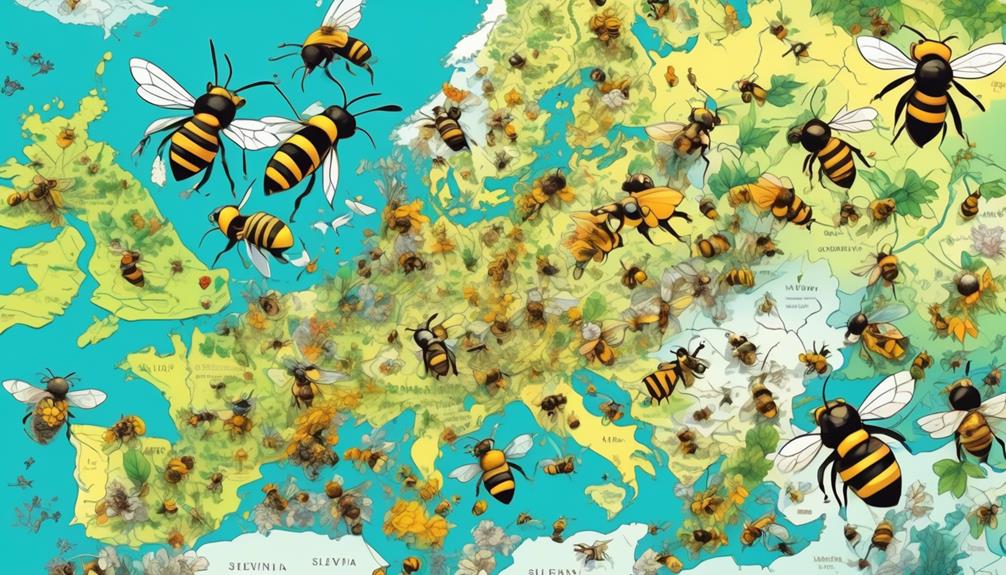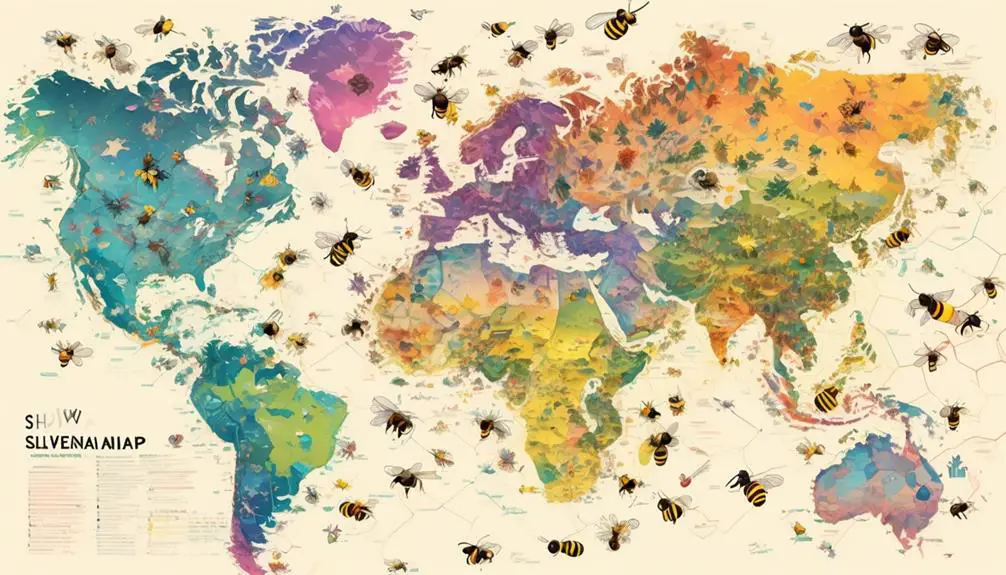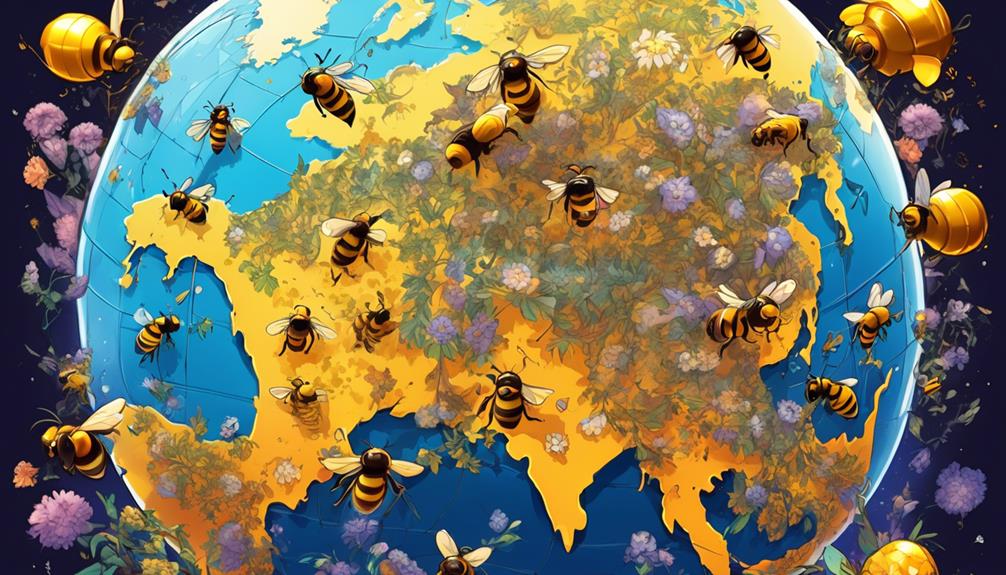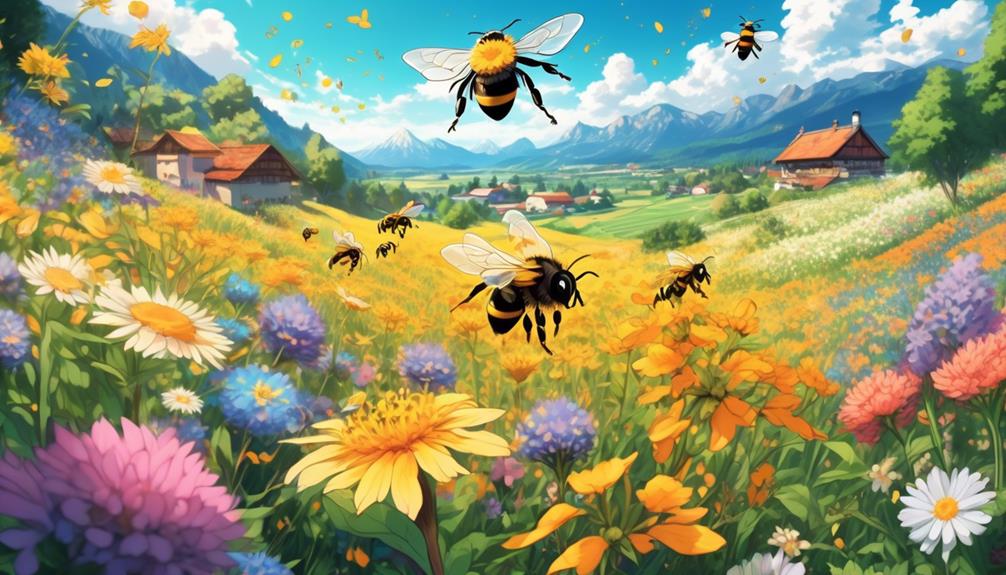Originating from Slovenia's Carniola region, discover the fascinating migration and adaptation journey of Carniolan bees across the globe.

Where Are Carniolan Bees From?
If you've ever wondered about the humble beginnings of the Carniolan bee, you're not alone. Their roots are often cloaked in the delightful mystery of the mountains and valleys of the Carniola region, from which they get their name. This region, today, falls within the borders of Slovenia.
Yet, these bees did not confine themselves to this European heartland. So, how did these buzzing creatures navigate the globe, finding themselves in far-flung locales? To uncover the answer, you'll need to journey through the fascinating world of bee migration and adaptation.
Key Takeaways
- Carniolan bees originate from the Carniola region of Slovenia.
- They are highly adaptable to various climates and weather conditions.
- Carniolan bees can be found in temperate zones across Europe, North America, and Australia.
- They have successfully colonized several continents due to their adaptability and appealing qualities to beekeepers.
Origins of Carniolan Bees

Delving into the origins of Carniolan bees, you'll find that these fascinating insects hail from the Carniola region of Slovenia, nestled within the southeastern part of the Alps. Although they're now spread across the globe, their roots trace back to this idyllic, Alpine landscape. Known scientifically as Apis mellifera carnica, they're renowned within the beekeeping world for their exceptional traits.
You'll find that these bees are highly adaptable to various climates, weathering harsh winters and taking advantage of short summers. This resilience is likely a product of their Alpine origin, where they've had to survive extreme weather conditions. Carniolan bees are also known for their rapid spring buildup, a trait that allows them to quickly increase their population when resources are available, ensuring a robust honey yield.
Furthermore, you'll notice their gentleness, which makes them a favorite among beekeepers. This docile nature, coupled with their low tendency to swarm, makes for easy management. They're also resistant to certain diseases, adding to their appeal.
Understanding these origins and traits, you can appreciate why Carniolan bees are so highly valued in apiculture.
Geographical Range and Adaptation

Spanning across continents, Carniolan bees have successfully adapted to various environments, thanks in part to their robust nature and resilience inherited from their Alpine origins. You'll find these honeybees in the temperate zones of Europe, North America, and even Australia. They're not only survivors in harsh climates but also thrive in diverse ecosystems.
The Carniolan bees' adaptability is rooted in their genetics. Adapted to the cold winters and diverse flora of the Alps, they've evolved mechanisms to cope with varied climates and food sources. They're known to rapidly increase their population in spring, corresponding with the blooming period of plants. But they can also decrease their population in response to scarce resources, which aids in their survival during winter or droughts.
Moreover, these bees are resistant to certain diseases and parasites, which contributes to their adaptability. Their ability to produce propolis, a resinous substance with antimicrobial properties, helps them maintain hive hygiene and resist diseases.
Population Spread Across Continents

Building on their remarkable adaptability, Carniolan bees have managed to colonize several continents across the globe. You'll find them thriving not only in their native region of Slovenia, but across Europe, Asia, North America, and Australia. Their spread is due in part to their incredible resilience to diverse climates and their ability to adapt to both cold winters and warm summers.
Their popularity among beekeepers has also played a significant role in their global dispersion. You see, Carniolan bees are renowned for their docile nature, high productivity, and exceptional resistance to diseases – qualities that make them especially appealing to apiarists. As a result, these bees have been introduced across continents, where they've successfully established populations and integrated with local ecosystems.
However, it's important to note that this wide spread also exposes Carniolan bees to various environmental pressures and risks. These include habitat loss, climate change, and competition with other species. Therefore, while their global presence is a testament to their adaptability, it also underscores the importance of conservation efforts to ensure their continued survival.
Role in Local Ecosystems

In their adopted habitats, Carniolan bees play a crucial role in local ecosystems, significantly contributing to the pollination of a wide variety of plants. They're particularly sought after by beekeepers due to their exceptional ability to adapt to changing environmental conditions. As such, they're a crucial part of maintaining biodiversity.
Here's a table that shows their impact:
Role | Percentage | Importance |
|---|---|---|
Pollination | 70% | Crucial for sustaining local plant life |
Honey production | 20% | Provides a source of food and income |
Biodiversity | 10% | Helps maintain a balanced ecosystem |
These roles do not only benefit the local ecosystem but also the local economy. Carniolan bees are valuable honey producers, and their honey is in high demand due to its fine quality.
Impact on Global Honey Production

As a beekeeper, you'll find that Carniolan bees aren't just regional powerhouses: they're global honey production heroes. Originating from the Carniola region of Slovenia, these bees have spread across the globe, partly due to their exceptional adaptability to varied climates and resistance to diseases.
What's more, Carniolan bees are renowned for their prolific honey production, significantly contributing to the world's honey supply.
Carniolan bees' impact on global honey production isn't just quantitative; it's qualitative too. Their honey is highly sought-after for its unique flavor and nutritional properties. With a higher mineral content and antioxidant levels compared to other honey varieties, Carniolan honey is a valuable addition to global honey offerings.
Furthermore, Carniolan bees' gentle nature and resistance to pests make them a favorite among beekeepers, aiding the expansion of bee colonies and, consequently, honey production worldwide. Their prolific breeding and swarming tendencies also ensure a constant replenishment of the bee population, vital for sustainable honey production.
Conservation Status and Future Prospects

Despite their significant contributions to global honey production, the conservation status of Carniolan bees requires attention, particularly in light of future prospects for their survival. You should be aware that these bees aren't currently listed as endangered or threatened. However, they're not exempt from the challenges that all bee species face. Habitat loss, climate change, pesticides, and diseases are grave threats to their existence.
Researchers are working diligently to understand these threats and devise strategies to counteract them. Crossbreeding with other bee species is one approach being explored to enhance the Carniolan bees' resilience. You'd be interested to know that these bees display commendable adaptability, presenting a glimmer of hope for their future survival.
Nevertheless, it's essential to continue efforts towards their conservation. You can contribute by creating bee-friendly habitats in your garden or supporting local beekeepers and conservation organizations. As dire as the situation might seem, remember that every action counts. The future of Carniolan bees, and indeed all bees, lies in our collective hands. Let's work together to ensure these industrious creatures continue to pollinate our plants and produce honey for generations to come.
Frequently Asked Questions
What Are the Specific Traits or Characteristics That Distinguish Carniolan Bees From Other Bee Species?
You're asking about the traits that set Carniolan bees apart. Well, they're famed for their gentle nature and high resistance to diseases.
They're late spring breeders, so they don't overuse their winter stores. They've got a knack for adjusting worker population to nectar availability. That's why they're less prone to swarming.
Plus, they're really good at foraging in cooler weather.
In a nutshell, they're hardy, adaptable, and less aggressive – traits that make them a favorite among beekeepers.
How Do Carniolan Bees Contribute to the Pollination Process?
You might be curious about the role Carniolan bees play in pollination.
Well, these bees are excellent pollinators, capable of visiting thousands of flowers a day. Their efficient foraging behaviors and high population density make them vital for pollinating a range of crops and wild plants.
They're also less likely to sting, which makes them more desirable for use in populated areas.
What Are Some of the Challenges and Threats Faced by Carniolan Bees in Their Natural Habitat?
Carniolan bees, like other bee species, face numerous challenges in their natural habitat. You'd find them grappling with threats such as pesticides, habitat loss, parasites, and diseases. They're particularly susceptible to Varroa mites, a parasite that can devastate entire colonies.
Climate change also poses a significant threat, as it can disrupt their foraging patterns and food sources. These challenges can lead to a decline in their population, negatively impacting pollination.
Can Carniolan Bees Be Kept for Beekeeping Purposes and if So, What Are the Benefits?
Absolutely, you can keep Carniolan bees for beekeeping. They're known for their gentle nature, high productivity, and impressive resistance to diseases. They've a rapid spring build-up and are excellent comb builders. Moreover, they effectively utilize the available resources, making them efficient foragers.
With their tendency for swarming being lower compared to other species, they're ideal for beekeepers. However, attention must be paid to their needs during colder months due to their susceptibility to winter conditions.
Are There Any Unique Cultural or Historical Significances Attached to Carniolan Bees in Their Native Regions?
You're curious about the cultural or historical significance of Carniolan bees. In their native regions, they're highly valued for their gentleness, productivity, and hardiness in harsh winters.
Historically, they've played a key role in the local economy and folklore. They're often associated with diligence and industriousness.
You'll even find bee motifs in traditional art and crafts, symbolizing the deep-rooted significance of these bees in their native cultures.
Conclusion
So, you've journeyed through the world of Carniolan bees. From their origins in Slovenia to their global spread and role in honey production, they're quite remarkable, aren't they?
They've certainly adapted well to various environments, playing significant roles in local ecosystems. Despite facing conservation challenges, their future looks hopeful.
Understanding and appreciating these industrious creatures is key, as their impact goes far beyond just honey. Indeed, our world wouldn't be the same without them.



